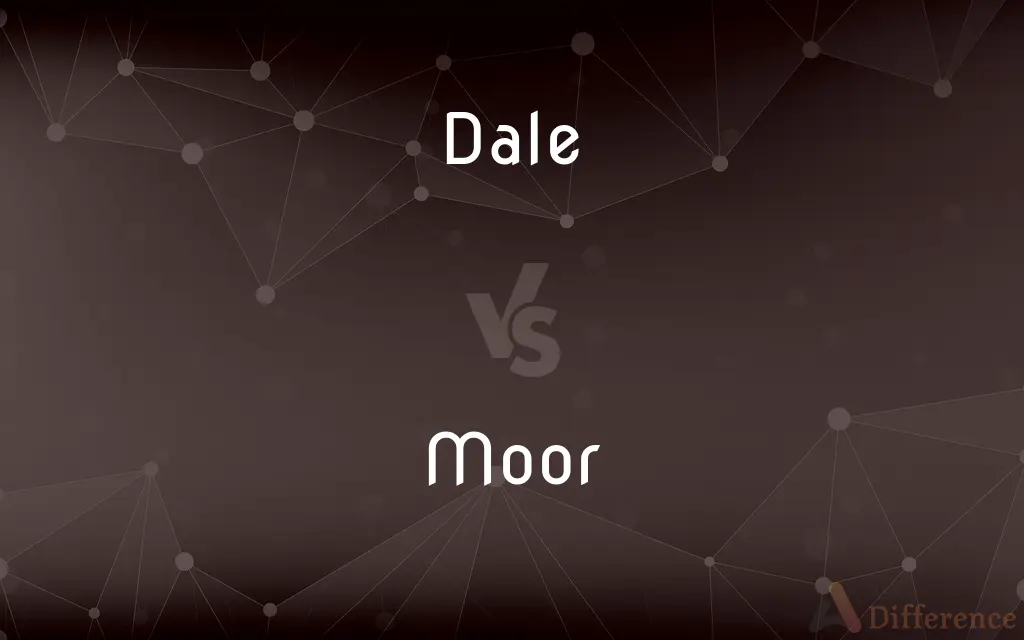Dale vs. Moor — What's the Difference?
Edited by Tayyaba Rehman — By Urooj Arif — Updated on April 17, 2024
Dale refers to a valley, especially a broad one, while a moor is a tract of open, uncultivated upland often covered with heather.

Difference Between Dale and Moor
Table of Contents
ADVERTISEMENT
Key Differences
A dale is typically a valley, often characterized by its lush, fertile landscape ideal for agriculture and settlement, whereas moors are defined by their open, often barren landscapes which are less suitable for intensive farming.
Dale landscapes usually feature rivers or streams, contributing to their greenery and richness in flora and fauna. In contrast, moors are usually found on higher grounds and are characterized by their wet, peaty soil, making them less hospitable for diverse plant life.
While dales often support a variety of wildlife due to their protective geography and vegetation, moors provide a habitat for specific species adapted to its harsher conditions.
Culturally, dales have been romanticized in literature and film, depicted as serene and picturesque locations, while moors are often portrayed as wild and mysterious places, adding a dramatic backdrop in stories and folklore.
Economically, dales are more likely to support villages and towns due to their arable land and water resources, on the other hand, moors are less populated, mainly used for grazing, hunting, and tourism.
ADVERTISEMENT
Comparison Chart
Landscape
Lush valleys with rivers or streams
Open, uncultivated upland
Soil
Fertile, well-drained
Wet, peaty, often acidic
Vegetation
Diverse, suitable for agriculture
Sparse, primarily heather and grass
Typical Use
Agriculture, settlements
Grazing, tourism
Cultural Depiction
Romanticized, serene
Mysterious, wild
Compare with Definitions
Dale
Fertile lowland.
Crops flourish in the rich soil of the dale.
Moor
High open land.
The moor stood vast and undisturbed under the cloudy sky.
Dale
Associated with rivers.
A winding river beautifies the dale, providing water to its fields.
Moor
Often wet and boggy.
The moor's ground squelched underfoot after the recent rains.
Dale
Often inhabited.
A small village nestles in the dale, shielded by hills.
Moor
Inspires folklore.
Legends of spectral hounds and eerie lights haunt the stories of the moor.
Dale
Featured in literature.
Many poets have celebrated the tranquility of the dale in their works.
Moor
Covered with heather.
Purple heather blooms dominate the landscape of the moor.
Dale
Broad valley.
The dale stretched green and vibrant under the summer sun.
Moor
Less suitable for farming.
The harsh conditions of the moor challenge any farming attempts.
Dale
A valley, especially in northern England.
Moor
To make fast (a vessel, for example) by means of cables, anchors, or lines
Moor a ship to a dock.
A dirigible moored to a tower.
Dale
A valley
Galloped over hill and dale.
Moor
To fix in place; secure
A mailbox moored to the sidewalk with bolts.
Dale
A valley, often in an otherwise hilly area.
Moor
To provide with an abiding emotional attachment
A politician moored to the family back home.
Dale
The sunken or grooved portion of the surface of a vinyl record.
Moor
To secure a vessel or aircraft with lines or anchors.
Dale
(archaic) A trough or spout to carry off water, as from a pump.
Moor
To be secured with lines or anchors
The freighter moored alongside the wharf.
Dale
A low place between hills; a vale or valley.
Where mountaines rise, umbrageous dales descend.
Moor
An uncultivated area covered with low-growing vegetation and often high but poorly drained.
Dale
A trough or spout to carry off water, as from a pump.
Moor
A member of a traditionally Muslim people of mixed Berber and Arab ancestry, now living chiefly in northwest Africa.
Dale
An open river valley (in a hilly area)
Moor
One of the Muslims who invaded Spain in the 8th century and established a civilization in Andalusia that lasted until the late 15th century.
Moor
One of a mixed race inhabiting Morocco, Algeria, Tunis, and Tripoli, chiefly along the coast and in towns.
Moor
Any individual of the swarthy races of Africa or Asia which have adopted the Mohammedan religion.
Moor
An extensive waste covered with patches of heath, and having a poor, light soil, but sometimes marshy, and abounding in peat; a heath.
In her girlish age she kept sheep on the moor.
Moor
A game preserve consisting of moorland.
Moor
To fix or secure, as a vessel, in a particular place by casting anchor, or by fastening with cables or chains; as, the vessel was moored in the stream; they moored the boat to the wharf.
Moor
Fig.: To secure, or fix firmly.
Moor
To cast anchor; to become fast.
On oozy ground his galleys moor.
Moor
One of the Muslim people of north Africa; of mixed Arab and Berber descent; converted to Islam in the 8th century; conqueror of Spain in the 8th century
Moor
Open land usually with peaty soil covered with heather and bracken and moss
Moor
Secure in or as if in a berth or dock;
Tie up the boat
Moor
Come into or dock at a wharf;
The big ship wharfed in the evening
Moor
Secure with cables or ropes;
Moor the boat
Common Curiosities
What is a moor?
A moor is a tract of open, uncultivated upland, typically covered with heather and often boggy.
Can you live in a moor?
Living in a moor is possible but challenging due to its less fertile land and harsher climate.
Are moors found in specific geographical locations?
Moors are commonly found in northern Europe, particularly in the UK, where they form significant landscapes.
What is a dale?
A dale is a broad valley, often fertile and lush, suitable for agriculture and settlements.
How are dales and moors different in terms of vegetation?
Dales typically have diverse vegetation due to fertile soil, whereas moors have sparse vegetation adapted to harsher conditions.
Are dales good for farming?
Yes, dales are often ideal for farming due to their fertile soil and ample water sources.
What activities are moors used for?
Moors are popular for activities like hiking, bird watching, and sometimes hunting.
What kind of wildlife is typical in a moor?
Moors are home to specialized wildlife, including certain birds like the red grouse and plants like heather.
What kind of wildlife can be found in a dale?
Dales support a wide range of wildlife, including birds, mammals, and various plant species.
Do dales have cultural significance?
Yes, dales are often depicted in literature and film as picturesque and tranquil settings.
Share Your Discovery

Previous Comparison
Abolishment vs. Abolition
Next Comparison
Patty vs. PaddyAuthor Spotlight
Written by
Urooj ArifUrooj is a skilled content writer at Ask Difference, known for her exceptional ability to simplify complex topics into engaging and informative content. With a passion for research and a flair for clear, concise writing, she consistently delivers articles that resonate with our diverse audience.
Edited by
Tayyaba RehmanTayyaba Rehman is a distinguished writer, currently serving as a primary contributor to askdifference.com. As a researcher in semantics and etymology, Tayyaba's passion for the complexity of languages and their distinctions has found a perfect home on the platform. Tayyaba delves into the intricacies of language, distinguishing between commonly confused words and phrases, thereby providing clarity for readers worldwide.
















































